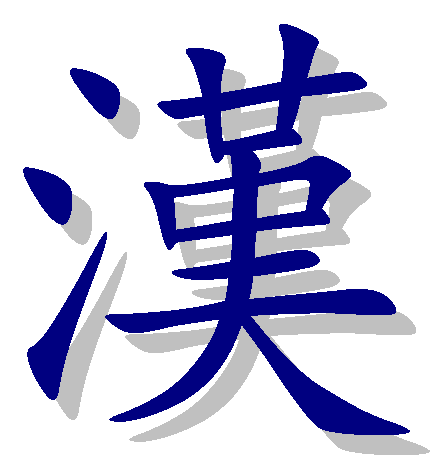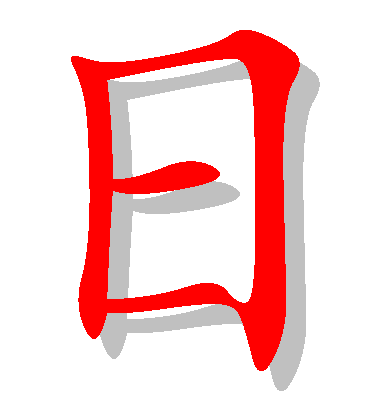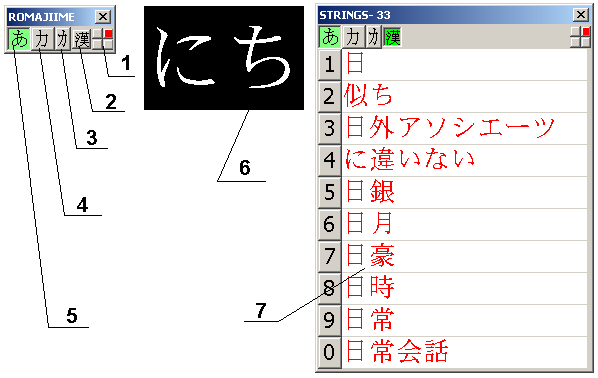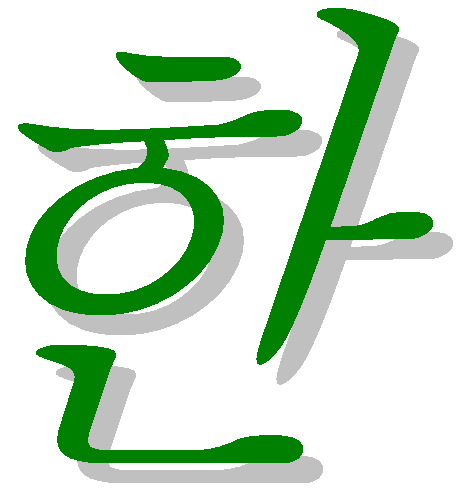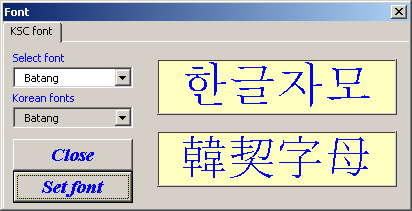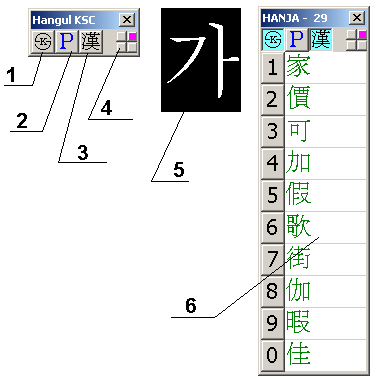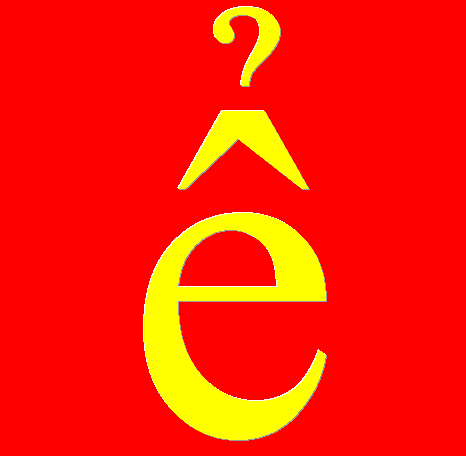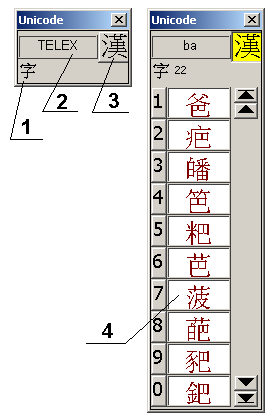Google+
CJKV VBA IME for MS Word
version 3.2
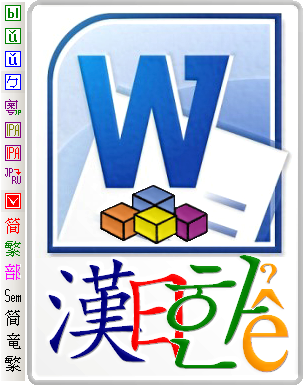 by WERTA© 2000–2014
by WERTA© 2000–2014
Instructions for use
With these macros you may enter any double-byte Asian characters and make
simple conversion of texts for East Asian languages. These macros are
includes: Chinese, Japanese, Korean, and Vietnamese units in the
dot-format files (MS Word templates).
Technical requirements
For
properly work of these macros you need the MS Word software installed
on your PC with MS Office version not 2000 earlier. These macros have
no digital signature, so after installation, you need change to low
security of your MS Word for work with VBA-macros, for example: (Tools
=> Macro => Security => Low). After run of MS Word or after
open any of the dot-files, you will see a new toolbars in MS Word
application. The binary files and conversion tables program path is
fixed and determined as C:\ CJKV_VBA.
1. Chinese Input Methods for MS Word.
1.1 List of IME
Input methods (character set) for Simplified Chinese (GB2312):
Phonetic (Mandarin)
GuoBiao (JianTi) PinYin
- standard Pinyin with using digitals for tones and input letter
«v» instead of «ü». Character set is
GB2312. Simplified Chinese characters are available. Keyboard layout is
Latin letters. Text input mode is single ideographic characters and you
can also input some Chinese words (tone digits is not use for it).
For
the Pinyin IMEs (GB and Big5) few variants of Latinized Chinese
transcription systems were added as a button control for a switching.
Five transcription systems variants were included for Standard Chinese
phonemes text input. By the cyclic switching of control button at the
right side of text edit field you can choice appropriate transcription
system what you need. After each clicking the color of button will be
change accordingly with follows systems list:
• Standard Pinyin (gray)
• Wade-Giles Romanization (green)
• MPS II (red)
• Yale Romanization (yellow)
• Tongyong PY (purple)
• Gwoyeu Romatzyh (blue), after phoneme input, you need to press space bar.
The without tones words input is available only in Standard Pinyin mode (gray button color).
GuoBiao (JianTi) ShuangPin
- input phoneme is available always with two keyboards clicks (called
ShuangPin). The first key press is corresponds to PinYin initial. The
second key press is corresponds to PinYin medial+final. Character set
is GB2312. Simplified Chinese characters are available. Text input mode
is single ideographic characters and you can also input some Chinese
words (tone digits is not use for it).
GuoBiao (JianTi) ZhuYin
- input based on Zhuyin Zimu alphabet. Character set is GB2312.
Simplified Chinese characters are available. Keyboard layout is
standard Bopomofo. Text input mode is single ideographic characters
only.
GuoBiao (FanTi) PinYin
- standard Pinyin, with using digitals for tones and input letter
«v» instead of «ü». Character set is
GB2312. Traditional Chinese characters are available. Keyboard layout
is Latin letters. Text input mode is single ideographic characters and
you can also input some Chinese words (tone digits is not use for it).
GuoBiao (FanTi) ShuangPin
- input phoneme is available always with two keyboards clicks (called
ShuangPin). The first key press is corresponds to PinYin initial. The
second key press is corresponds to PinYin medial+final. Character set
is GB2312. Traditional Chinese characters are available. Text input
mode is single ideographic characters and you can also input some
Chinese words (tone digits is not use for it).
GuoBiao (FanTi) ZhuYin
- input based on Zhuyin Zimu alphabet. Character set is GB2312.
Traditional Chinese characters are available. Keyboard layout is
standard Bopomofo. Text input mode is single ideographic characters
only.
Structural methods
GuoBiao (JianTi) CangJie
- input with CangJie system. The maximum length of the input string is
5 characters. Character set - GB2312. Simplified Chinese characters are
available. Keyboard layout is standard CangJie. The selection of
characters for the input list is performs by matching of the entered
part of the coding CangJie stroke. The input mode is single input of
ideographic character only.
GuoBiao (JianTi) CangJie (exact)
- input with CangJie system. The maximum length of the input string is
5 characters. Character set is GB2312. Simplified Chinese characters
are available. Keyboard layout is standard CangJie. The selection of
characters for the input list is performs by both matching of the
entered part of the encoding CangJie stroke and the total length of
encoding CangJie stroke. The input mode is single input of ideographic
character only.
GuoBiao (JianTi) WuBi
- input with Wubi system. The maximum length of the input string is 4
characters. Character set is GB2312. Simplified Chinese characters are
available. Keyboard layout is standard WuBi. Input modes is type of
single ideographic character only.
Phonetic (Dialects)
GuoBiao (JT/FT) Shanghai IME
– this is an input with standard Latin transcription system for
Shanghainese with the numerical tones designation (0-5). Character set
is GB2312. In the ideographs choice list you can see both simplified
and traditional hanzi. For this input method the keyboard layout is
standard English. The input mode is type of single ideographic
character only.
GuoBiao (JT/FT) Wu IME –
this is an input with generalized Latin transcription system for Wu
dialects without any numerical tones designation. Character set is
GB2312. In the ideographs choice list you can see both simplified and
traditional hanzi. For this input method the keyboard layout is
standard English. The input mode is type of single ideographic
character only. For activation the list of choice you need just press
space bar after input of Wu phoneme.
Input methods (character set) for Traditional Chinese:
Phonetic (Mandarin)
Big5 PinYin
- standard Pinyin, with using digitals for tones and input letter
«v» instead of «ü». Character set is BIG5.
Traditional Chinese characters are available. Keyboard layout is Latin
letters. Text input mode is typing of single ideographic characters and
you can also input some Chinese words (tone digits is not use for it).
Big5 ShuangPin
- input phoneme is available always with two keyboards clicks (called
ShuangPin). The first keypress is corresponds to PinYin initial. The
second keypress is corresponds to PinYin medial+final. Character set is
BIG5. Traditional Chinese characters are available. Text input mode is
typing of single ideographic characters and you can also input some
Chinese words (tone digits is not use for it).
Big5 ZhuYin
- input based on Zhuyin Zimu alphabet. Character set is BIG5.
Traditional Chinese characters are available. Keyboard layout is
standard Bopomofo. Text input mode is type of single ideographic
character only.
Structural methods
Big5 CangJie
- input with CangJie system. The maximum length of the input string is
5 characters. Character set - BIG5. Traditional Chinese characters are
available. Keyboard layout is standard CangJie. The selection of
characters for the input list is performs by matching of the entered
part of the coding CangJie stroke. The input mode is type of single
ideographic character only.
Big5 CangJie (exact)
- input with CangJie system. The maximum length of the input string is
5 characters. Character set is BIG5. Traditional Chinese characters are
available. Keyboard layout is standard CangJie. The selection of
characters for the input list is performs by both matching of the
entered part of the encoding CangJie stroke and the total length of
encoding CangJie stroke. The input mode is single input of ideographic
character only.
Big5 Array30
- input with Array30 system. The maximum length of the input string is
4 characters. Character set is BIG5. Traditional Chinese characters are
available. Keyboard layout is Array30. The selection of characters for
the input list is performs by matching of the entered part of the
coding Array30 stroke. The input mode is type of single ideographic
character only.
Big5 Boshiamy
- input with Boshiamy system. The maximum length of the input string is
4 characters. Character set is BIG5. Traditional Chinese characters are
available. Keyboard layout is Boshiamy. The selection of characters for
the input list is performs by matching of the entered part of the
coding Boshiamy stroke. The input mode is type of single ideographic
character only.
Big5 DaYi (4)
- input with DaYi system. The maximum length of the input string is 4
characters. Character set - BIG5. Traditional Chinese characters are
available. Keyboard layout is DaYi. The selection of characters for the
input list is performs by matching of the entered part of the coding
DaYi stroke. The input mode is type of single ideographic character
only.
Phonetic methods (Chinese dialects)
Big5 Cantonese PY
- input with Cantonese transcription without tone digits. Character set
is BIG5. Traditional Chinese characters are available. Keyboard layout
is standard Latin. The input mode is type of single ideographic
character only.
Big5 Hakka PY
- input with transcription for Hakka dialects, with digital marking of
tones (1-6). Character set is BIG5. Traditional Chinese characters are
available. Keyboard layout is standard Latin. The input mode is type of
single ideographic character only.
Input methods for UNICODE CJK extensions
PinYin IME (CJK Unified + ExtA)
- input with Standard Pinyin with digital Chinese tones designation
(1-5) and with letter «v» instead of «ü».
A set of characters for enter is Unicode: CJK Unified + CJK ExtA.
Keyboard layout is standard Latin. The input mode is type of single
ideographic character only.
JyutPing IME (CJK Unified + ExtA)
- input with Standard Jyutping with digital Chinese tones designation
(1-6). A set of characters for enter is Unicode: CJK Unified + CJK
ExtA. Keyboard layout is standard Latin. The input mode is type of
single ideographic character only.
CangJie IME (CJK Unified + ExtA)
- input with CangJie system. The maximum length of the input string is
5 characters. A set of characters for enter is Unicode: CJK Unified +
CJK ExtA. Keyboard layout is standard CangJie. The selection of
characters for the input list is performs by matching of the entered
part of the coding CangJie stroke. The input mode is type of single
ideographic character only.
CangJie IME (CJK Unified + ExtA) exact
- input with CangJie system. The maximum length of the input string is
5 characters. A set of characters for enter is Unicode: CJK Unified +
CJK ExtA. Keyboard layout is standard CangJie. The selection of
characters for the input list is performs by both matching of the
entered part of the encoding CangJie stroke and the total length of
encoding CangJie stroke. The input mode is single input of ideographic
character only.
CangJie IME (ExtB)
- input with CangJie system. The maximum length of the input string is
5 characters. A set of characters to enter is Unicode CJK ExtB.
Keyboard layout is standard CangJie. The selection of characters for
the input list is performs by matching of the entered part of the
coding CangJie stroke. The input mode is type of single ideographic
character only.
CangJie IME (ExtB) exact
- input with CangJie system. The maximum length of the input string is
5 characters. A set of characters to enter - Unicode CJK ExtB. Keyboard
layout - standard CangJie. The selection of characters for the input
list is performs by both matching of the entered part of the encoding
CangJie stroke and the total length of encoding CangJie stroke. The
input mode is single input of ideographic character only.
1.2 Conversion of text
For conversion you need just select the text and press the button with macro.
Mandarin
HanZi to PinYin (CJK Unified + ExtA)
- selected characters will be converted to Pinyin transcription with
digital marking of Chinese tones and with text separator such as space,
for example:
[HZ1] [HZ2] [HZ3] -> pinyin1 pinyin2 pinyin3
If
the Chinese character has more than one reading, the alternate versions
of the transcription will be enclosed in parentheses with comma
separator inside, for example:
[HZ1] [HZ2] [HZ3] -> pinyin1 (pinyin2_1, pinyin2_2, pinyin2_3) pinyin3
For conversion of Chinese ideographs are available following Unicode ranges: CJK Unified + CJK ExtA.
For example:
我喜欢电脑游戏
wo3 xi3 huan1 dian4 nao3 you2 (xi4 , hu1 , hui1)
HZ Colored Tones –
this text function is converts uncolored selected hanzi into colored
same string with specified color for each ideograph. A color
corresponded with one of the four main Putonghua tones. Black color is
the first tone, red is the second tone, blue is third tone and green
color is fourth tone. Blinking pink color is means that the ideograph
has a more one tone in readings. Purple color is means that was
occurred sandhi conversion of two ideographs reading repeatedly with
third tones both (without words analysis).
For example:
我喜欢电脑游戏
我喜欢电脑游戏
1.2.1 Conversion with other Pinyin standards
PinYin to…, …to PinYin –
this is functions for direct and inverse conversion of standard Pinyin
phoneme and other Pinyin standard transcriptions. There are few
standards in macros:
• Wade-Giles (WD)
• Yale Romanization (YL)
• MPS II (MPS)
• TongYong Pinyin (TY)
• Gwoyeu Romatzyh (GW)
To
conversion you need select phonemes in text and with a space divider,
after you need to press one of the buttons with macros on the submenu.
For example (PY->Yale Romanization):
wo3 xue2 xi2 zhong1 wen2
wo3 sywe2 syi2 jung1 wen2
PinYin to IPA - this function is converts Pinyin phonemes with a digital Chinese tones designation to the symbols of IPA system.
For example:
wo3 xi3 huan1 dian4 nao3 you2 xi4
wuɔ²¹⁴ ɕʅ²¹⁴ huɑn⁵⁵ tiɛn⁵¹ nɑʊ²¹⁴ jɤʊ¹⁵ ɕʅ⁵¹
PY to ZY - this function is converts Pinyin phoneme with digital Chinese tones designation in the stroke of Zhuyin Zimu alphabet.
For example:
wo3 xi3 huan1 dian4 nao3 you2 xi4
ㄨㄛˇ ㄒㄧˇ ㄏㄨㄢ ㄉㄧㄢˋ ㄋㄠˇ ㄧㄡˊ ㄒㄧˋ
PY to ZY (fixed)
- this function is converts Pinyin phoneme with digital Chinese tones
designation in the stroke of Zhuyin Zimu alphabet with fixed positions
for four character cells in resulting string. I.e. if the medial
phoneme zero, it will be inserted instead by the Asian monospace gap
for aligning.
For example:
wo3 xi3 huan1 dian4 nao3
| ㄨㄛˇ|ㄒㄧ ˇ| ㄏㄨㄢ |ㄉㄧㄢˋ| ㄋ ㄠˇ|
PY to RU
- this function is converts Pinyin phonemes with a digital Chinese
tones designation in the Palladius Cyrillic transcription system stroke
with digital symbolic for tones designation.
For example:
wo3 xi3 huan1 dian4 nao3 you2 xi4
во3 си3 хуань1 дянь4 нао3 ю2 си4
PY to PY (tone marks)
- this function is converts Pinyin phonemes with the digital
designation of Chinese tones in the stroke of standard Putonghua Pinyin
with diacritical tone symbols placed under the vowels.
For example:
wo3 xi3 huan1 dian4 nao3 you2 xi4
wǒ xǐ huān diàn nǎo yóu xì
PY (tone marks) to PY
- this function is converts string of standard Putonghua Pinyin with
diacritical tone symbols placed under the vowels in the equivalent
Pinyin stroke with a digital designation of Chinese tone.
For example:
wǒ xǐ huān diàn nǎo yóu xì
wo3 xi3 huan1 dian4 nao3 you2 xi4
ZY to PY (only one phoneme)
- this function is converts a single phoneme text typed in Zhuyin Zimu
alphabet into a phoneme typed with a standard Pinyin and with digital
designation of Chinese tone.
For example:
ㄉㄧㄢˋ => dian4
Kill Tones - this function is removes symbols indicated the tone designations used in transcription system PinYin or ZhuYin.
For example:
wo3 xi3 huan1 dian4 nao3 you2 xi4
(or)
wǒ xǐ huān diàn nǎo yóu xì
---------------------------------
wo xi huan dian nao you xi
Cantonese
HanZi to JyutPing (CJK Unified + ExtA)
- selected characters will be converted to Jyutping transcription with
digital designation of Cantonese tone and with text separator such as
space, for example:
[HZ1] [HZ2] [HZ3] -> jyutping1 jyutping2 jyutping3
If
the character has more than one reading, the alternate versions of the
transcription will be enclosed in parentheses with comma separator
inside, for example:
[HZ1] [HZ2] [HZ3] -> jyutping1 (jyutping2_1, jyutping2_2) jyutping3
Characters that are available for conversion are in Unicode: CJK Unified + CJK ExtA.
For example:
我喜欢电脑游戏
ngo5 hei2 fun1 din6 nou5 jau4 (fu1, hei3)
JyutPing to IPA (GD) - this function converts a digital transcription Jyutping with digital designation of Cantonese tone into IPA string (Guandong)
For example:
baak1 ging1 si6 zung1 gwok3 dik1 sau2 dou1
pa:k⁵ kiŋ⁵⁵ si¹¹ tɕʊŋ⁵⁵ kʷɔk³ tik⁵ sɐu²⁵ tou⁵⁵
JyutPing to IPA (HK) - this function converts a digital transcription Jyutping with digital designation of Cantonese tone into IPA string (HK)
For example:
baak1 ging1 si6 zung1 gwok3 dik1 sau2 dou1
pa:k⁵ kiŋ⁵⁵ si¹¹ tsʊŋ⁵⁵ kʷɔk³ tik⁵ sɐu²⁵ tou⁵⁵
JyutPing to RU - this function converts Jyutping with digital indication of Cantonese tone into Cyrillic transcription for Cantonese.
For example:
ngo5 hei2 fun1 din6 nou5 jau4 fu1
нго5 хэй2 фунь1 тинь6 ноу5 яу4 фу1
Ideographs conversion
FanTi to JianTi (GuoBiao) - this function is converts the traditional Chinese characters into simplified form (GB2312 charset only).
For example:
我喜歡電腦游戲
我喜欢电脑游戏
JianTi to FanTi (GuoBiao) - this function is converts the simplified Chinese characters into traditional form (GB2312 charset only).
For example:
我喜欢电脑游戏
我喜歡電腦游戲
HZ to Radical (CJK Unified + ExtA)
- this function is converts Chinese characters from the ranges Unicode:
CJK Unified + CJK ExtA into Bushou character from the list of 214 Kang
Xi radicals. The radical characters of Chinese ideographs are
determined in accordance with sorting within the Unicode standard.
For example:
北京是中国的首都
匕亠日丨囗白首邑
HZ to Semantic Variant - this function is converts a Chinese character from the ranges of Unicode: CJK Unified + CJK ExtA into semantic variant.
For example:
简 => 耕
HZ to JianTi Variant - this function is converts Chinese character from the ranges of Unicode: CJK Unified + CJK ExtA into a simplified form.
For example:
簡體漢字 => 简体汉字
HZ to SpecSimpl Variant
- this function is converts Chinese character from the ranges of
Unicode: CJK Unified + CJK ExtA into a special simplified form (for
example: Japanese shintaiji, ryakuji).
For example:
龍 => 竜
HZ to FanTi Variant - this function is converts Chinese character from the ranges of Unicode: CJK Unified + CJK ExtA into a traditional form.
For example:
简体汉字 =>簡體漢字
HZ to Z-Variant - this function is converts Chinese character from the ranges of Unicode: CJK Unified + CJK ExtA into a Z-variant form.
For example:
繁 => 緐
CJK HZ to Compatibility Char - this function is converts Chinese character from the ranges of Unicode: CJK Unified + CJK ExtA into a compatibility form.
Compatibility Char to CJK HZ
- this function is converts compatibility form of Chinese character
into a usual character form from Unicode ranges: CJK Unified + CJK ExtA.
Conversions for CangJie
ABC to CJ Code - this text function is converts the Latin alphabet characters into the hieroglyphic key symbols of CangJie input system.
For example:
LMP YRF
中一心 卜口火
CJ code to ABC - this text function is converts the hieroglyphic key symbols of CangJie input system in the Latin alphabet characters.
For example:
中一心 卜口火
LMP YRF
HZ to CJ Code (ABC) (CJK Unified + ExtA)
- this text function is converts the Chinese characters from the ranges
Unicode: CJK Unified + CJK ExtA into CangJie system encoding string
using Latin alphabet symbols.
For example:
北京 => LMP YRF
Other
HanZi to Unicode (Dec) - this function is converts selected
Chinese characters in decimal code. After conversion between obtained
numerical values the space separators will be placed.
For example:
北京是中国的首都
21271 20140 26159 20013 22269 30340 39318 37117
HanZi to Unicode (Hex) - this function is converts selected
Chinese characters in hexadecimal code. After conversion between
obtained numerical values the space separators will be placed.
For example:
北京是中国的首都
5317 4EAC 662F 4E2D 56FD 7684 9996 90FD
1.3 CJK-decomposition module
As a main base for determining of Chinese ideographs decomposition the
Ideographic Description Sequence (U+2FF0 – U+2FFB) was adopted.
However for some decomposition types the interpretation was a little
bit changed. It was cased due a strongly binary conception for Chinese
Ideographs composition schemes which historically were formed as a
simple formula: radical + phonetic. And now decomposition must be
described by following components:
• first symbol – radical (or more complex symbol with radical);
• ideographic decomposition symbol;
• second symbol – usually phonetic (or just second component);
• radical order in ideograph (first or last);
• extended decomposition for first symbol (if absent in Unicode);
• extended decomposition for second symbol (if absent in Unicode);
Extended decomposition is if the first or the second symbols there are not included in Unicode standard.
CJK Full Decomposition – text conversion function which
performs full decomposition of Chinese ideograph. In the resulting
string the ”=” sign will be added after each decomposing
ideograph. Just select text for decomposition and after press button
with macro.
For example:
愂=((((十⿱冖)⿱子)⿰力)⿱心)
惕=忄⿰(日⿱(勹⿹(丿⿰丿)))
CJK Full Decomposition (rad simpl) – text conversion
function which performs full decomposition of Chinese ideograph.
Graphical variants of any radicals will be simplified to the main
radical form. In the resulting string the ”=” sign will be
added after each decomposing ideograph. Just select text for
decomposition and after press button with macro.
For example:
惕=心⿰(日⿱(勹⿹(丿⿰丿)))
CJK Full Decomposition (prefix) –
text conversion function which performs full decomposition of Chinese
ideograph with classical (IDS) prefix format of resulting decomposition
sequence string. In the resulting string the ”=” sign will
be added after each decomposing ideograph. Just select text for
decomposition and after press button with macro.
For example:
惕=⿰忄⿱日⿹勹⿰丿丿
CJK Full Decomposition (prefix) (rad simpl) –
text conversion function which performs full decomposition of Chinese
ideograph with classical (IDS) prefix format of resulting decomposition
sequence string. Graphical variants of any radicals will be simplified
to the main radical form. In the resulting string the ”=”
sign will be added after each decomposing ideograph. Just select text
for decomposition and after press button with macro.
For example:
惕=⿰心⿱日⿹勹⿰丿丿
CJK Ideographic Decomposition – text conversion function
which performs one act decomposition of Chinese ideograph in format
[HZ]=[C1]{decomp}[C2]. In the resulting string the ”=” sign
will be added after each decomposing ideograph. Just select text for
decomposition and after press button with macro.
For example:
湕=氵⿰建
CJK Ideographic Decomposition (rad simpl) – text conversion
function which performs one act decomposition of Chinese ideograph in
format [HZ]=[C1]{decomp}[C2]. Graphical variants of any radicals will
be simplified to the main radical form. In the resulting string the
”=” sign will be added after each decomposing ideograph.
Just select text for decomposition and after press button with macro.
For example:
湕=水⿰建
CJK Ideographic Decomposition (...) – text conversion
function which performs one act decomposition of Chinese ideograph in
format ([C1]{decomp}[C2]).Just select text for decomposition and after
press button with macro. Resulting string will type instead the
selected ideograph.
For example:
湕=>(氵⿰建)
CJK Ideographic Decomposition (...) (rad simpl) –
text conversion function which performs one act decomposition of
Chinese ideograph in format ([C1]{decomp}[C2]). Graphical variants of
any radicals will be simplified to the main radical form. Just select
text for decomposition and after press button with macro. Resulting
string will type instead the selected ideograph.
For example:
湕=>(水⿰建)
CJK Ideographic Decomposition (prefix) – text conversion function which performs one act decomposition of Chinese ideograph in format [HZ]={decomp}[C1][C2].
In the resulting string the ”=” sign will be added after
each decomposing ideograph. Just select text for decomposition and
after press button with macro. Resulting string will type instead the
selected ideograph.
For example:
湕=⿰氵建
CJK Ideographic Decomposition (prefix) (rad simpl) – text conversion function which performs one act decomposition of Chinese ideograph in format [HZ]={decomp}[C1][C2].
In the resulting string the ”=” sign will be added after
each decomposing ideograph. Graphical variants of any radicals will be
simplified to the main radical form. Just select text for decomposition
and after press button with macro. Resulting string will type instead
the selected ideograph.
For example:
湕=⿰水建
CJK Ideographic Decomposition Determinative – text
conversion function which returns determinative (radical) of Chinese
ideograph. Just select text for decomposition and after press button
with macro. Resulting string will type instead the selected ideograph.
For example:
湕=>氵
CJK Ideographic Decomposition Determinative (rad simpl) –
text conversion function which returns determinative (radical) of
Chinese ideograph. Graphical variants of any radicals will be
simplified to the main radical form. Just select text for decomposition
and after press button with macro. Resulting string will type instead
the selected ideograph.
For example:
湕=>水
CJK Ideographic Decomposition Phonetic
– text conversion function which returns phonetic part of Chinese
ideograph. Just select text for decomposition and after press button
with macro. Resulting string will type instead the selected ideograph.
For example:
湕=>建
CJK Radical and Strokes Count
– text conversion function which returns radical sign (according
to Unicode standard), total strokes and strokes for additional
component of Chinese ideograph. Just select text for decomposition and
after press button with macro. Resulting string will type instead the
selected ideograph.
For example:
湕=>水(11/9)
CJK Radicals Composition (form) – two components input method.
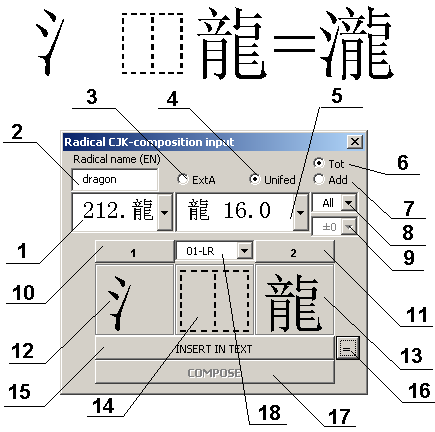
1 – combo box to selecting of 214 Kang Xi radicals
2 – text box for input of radical English names (if the name is
correct, then radical will be selected automatically in combo box 1).
The English names of radicals see in Appendix.
3 – radio button enables the choice for the composition components getting from Unicode CJK Ext A diapason only.
4 – radio button enables the choice for the composition
components getting from Unicode CJK Unifed Ideographs diapason only.
5 - select the character for the composition from list generated by
selected radical after applying filter for the number of strokes
6 - filter works only with total number of strokes in character
7 - filter works only with number of strokes for additional non-radical part
8 - number of strokes (total or additional) for filter to generate characters list in 5
9 - set the threshold for number of strokes (total or additional) for filter to generate characters list in 5
10 - button for input the first character from element 5 to the composition
11 - button for input the second character from element 5 to the composition
12 – text label displaying the first character for composition (double click - type into the text)
13 - text label displaying second character for composition (double click - type into the text)
14 - text label displaying Unicode decomposition symbol (double click - type into the text )
15 - button for input whole composition into the text
16 - button for input "=" sign into the text
17 - button to enter in text the resulting one ideograph from the
source two characters composition (activated if ideograph is present in
Unicode standard)
18 – combo box to select the symbols of Unicode Ideographs Description Sequence (about mnemonics see in Appendix)
For input ⺼“meet” left-position or ⻏ “city”
right position radicals you will choose these components from CJK
supplementary radicals (U+2E80 – U+2EF3).
CJK Radicals Compose (3 symbols) – text conversion function
which converts three symbols in string as [C1]{compos}[C2] into
resulting ideograph (like the CJK Radicals Composition (form)). Just select text (always – three characters) before composition
and after press button with macro. The ideograph will be just typed
instead of selected text if result of such composition included in
Unicode standard.
For example:
氵⿰龍
瀧
CJK Radicals Compose Prefix (3 symbols) - Text conversion function which converts three symbols in string as {compos}[C1][C2]
into resulting ideograph (like the CJK Radicals Composition
(form)). Just select text (always – three characters)
before composition and after press button with macro. The ideograph
will be just typed instead of selected text if result of such
composition included in Unicode standard.
For example:
⿰氵龍
瀧
Decomposition Symbol to Mnemonics – CJK Decomposition
Description Unicode symbols (U+2FF0 – U+2FFB) will be converted into
text mnemonics (see Appendix).
For example:
湕=水⿰建
湕=水[LR]建
Delete Decomposition Symbols – CJK Decomposition
Description Unicode symbols (U+2FF0 – U+2FFB) will be converted into
commas and all parentheses will be deleted from selected text.
For example:
腍=(⺼⿰((亼⿱乛)⿱心))
腍=⺼,亼,乛,心
It will be useful for displaying of radicals set in the decomposed ideograph.
Decomposition Symbols Count
– in the selected text all CJK Decomposition Description Unicode
symbols (U+2FF0 – U+2FFB) will be counted. The resulting number will
be typed instead of selected text.
For example:
腍=(⺼⿰((亼⿱乛)⿱心))
腍=3
It will be useful to counting and displaying of logical complexity for
one ideograph. Other words, this is a total number of binary
composition operations among radical graphemes.
1.4 Select fonts
Font - this function is allows to select fonts to display the input text and text in the input form.
Selecting a font character set for GB2312
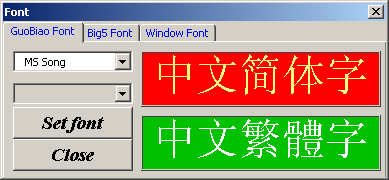
Selecting a font character set for BIG5
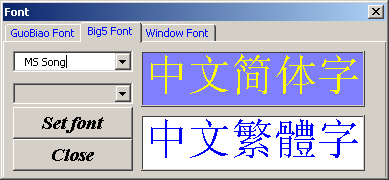
Selecting a font to display text in the input form
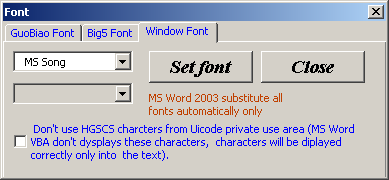
1.5 Input form
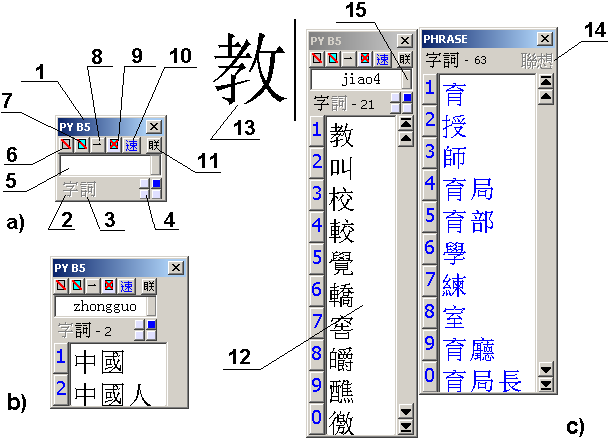
1 - short name of active IME
2 - one-char mode indicator
3 - words-mode indicator (only for Pinyin) - b)
4 - indicator of the input form position on the screen
5 - input text box
6 - reset the selection list after closing the related words form
7 - close the form with related words after the insertion char in the text
8 - just insert into the text, if the list of candidate has only one char
9 - disable the input of related words
10 - insert into the text first character from selection candidates list
11 - button to activate the LianXiang-mode for entering related words
12 - selection candidates list (words or characters)
13 - character typed in the text
14 - enable LianXiang-mode indicator
15 – PinYin Latin transcription systems switcher (for PinYin IMEs only)
a) - main input form, c) - related words input form.
2. Japanese Input Methods for MS Word.
2.1 List of IME
Japanese Romaji -
this is kana input by using Latin transcription (Romaji). Character
input modes (Hira, Kata, HW-Kata, Kanji) can be switched by appropriate
buttons on the input form. Default kana input is hiragana mode. Note,
that sometimes to enter the closing syllable symbol ん (-n) you need to
double press N. Reset input buffer by pressing Esc when you want. You
can also activate the kanji input mode with the selection candidates
list displayed on the input form.
Japanese Hiragana
- this is kana input by using Latin transcription (Romaji). Character
input modes (Hira, Kata, HW-Kata, Kanji) can be switched by appropriate
buttons on the input form. Default kana input is hiragana mode. Reset
input buffer by pressing Esc when you want. You can also activate the
kanji input mode with the selection candidates list displayed on the
input form.
Japanese FourCorner
- this is the input of kanji with 4Corner system (Four Corners). The
maximum length of the input string is 5 characters. Characters set for
input is (0-9). Additional input also is available for the Japanese
kana characters layout. You can input kanji from the selection list by
pressing a number key. But it will be available when the length of the
4Corner encoding string will reach 5 characters. If the length of
4Corner encoding string is less than 5, you can input kanji by mouse
click.
2.2 Conversion of text
You need just select the text and press the button with macro.
Hiragana to Romaji (simple) - this text function is converts the
hiragana text into romaji text string (without analysis of kana
characters neighboring in the converted text)
For example:
ぼくのせんせいがです
bokunosenseigadesu
Katakana to Hiragana - this text function is converts hiragana text string into katakana text string.
For example:
ボクノセンセイガ
ぼくのせんせいが
Hiragana to Katakana - this text function is converts katakana text string into hiragana text string.
For example:
ぼくのせんせいが
ボクノセンセイガ
Hiragana to HalfW Katakana - this text function is converts hiragana text string into half-width katakana text string.
For example:
ぼくのせんせいが
ボクノセンセイガ
Kanji to Radical - this text function is converts kanji into the
radical char from the list of 214 Kang Xi radicals. The radical
characters are determined in accordance with sorting into the Unicode
standard. Available char set for conversion is CJK Unifed Ideographs.
For example:
著書南嶋探験
艸曰十山手馬
Kyutaiji to Sintaiji - this text function is converts kanji from traditional style to simplified Japanese kanji style.
For example:
驗=>験
Sintaiji to Kyutaiji - this text function is converts kanji from simplified Japanese Kanji style to traditional style.
For example:
験=>驗
Kanji to Unicode (Dec) - this function is converts selected
kanji into decimal code. After conversion the space separators will be
placed among obtained numerical values.
For example:
著書南嶋探験
33879 26360 21335 23947 25506 39443
Kanji to Unicode (Hex) - this function is converts selected
Chinese characters in hexadecimal code. After conversion the space
separators will be placed among obtained numerical values.
For example:
著書南嶋探験
8457 66F8 5357 5D8B 63A2 9A13
2.3 Select fonts
Font - this function is allows to select fonts to display the input text and text in the input form.
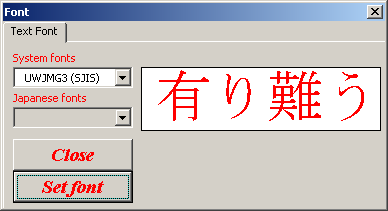
1 - indicator of input form position on the screen
2 - indicator for enabling kanji mode
3 - indicator for enabling half-width katakana mode
4 - indicator for enabling katakana mode
5 - indicator for enabling hiragana mode
6 - text input
7 - list of candidates for single kanji or words
8 - short name of the input method.
3. Korean Input Methods for MS Word.
3.1 List of IME
Hangul (BeolSik)
- input Hangul phonemes with a standard Korean keyboard layout (Beol
Sik). You can reset the input buffer by pressing Esc. It is possible to
activate the hanja input mode from the selection list (press
appropriate button). You can activate the input for simple words by the
entered first Hangeul syllable. Also you can enter all Hangul phonemes
included in the Unicode standard. Button on the input form may enable
KSC-only mode to filtering Hangeul phonemes input. Thus it will be
input with Hangul phonemes only included into Korean national standard
(KSC).
Hangul (LatinABC)
- input Hangul phonemes with a simplified Korean romanization scheme
(like for isolated phonemes) by Latin keyboard layout. You can reset
the input buffer by pressing Esc. It is possible to activate the hanja
input mode from the selection list (press appropriate button). You can
activate the input for simple words by the entered first Hangeul
syllable. Also you can enter all Hangul phonemes included in the
Unicode standard. Button on the input form may enable KSC-only mode to
filtering Hangeul phonemes input. Thus it will be input with Hangul
phonemes only included into Korean national standard (KSC).
3.2 Conversion of text
For conversion you need just select the text and press a button with macro.
Hangul to String - this text conversion function is splits Hangeul phonemes into string of Hangul Jamo letters that included in this phoneme.
For example:
곺 => ㄱ ㅗ ㅍ
Hangul (Isolated) to New Romanization 2000
– simplified text conversion function for isolated Hangeul
phonemes. One Hangeul phoneme will be converted into string of New
Korean Romanization standard without any analysis of neighbor phonemes
and position in words. After conversion the space will be divider
between phonemes Romanized words.
For example:
한글 자모
han geul ja mo
Hangul (Isolated) to Yale Romanization
– simplified text conversion function for isolated Hangeul
phonemes. One Hangeul phoneme will be converted into string of Yale
Romanization standard without any analysis of neighbor phonemes and
position in words. After conversion the space will be divider between
phonemes Romanized words.
For example:
한글 자모
han kul ca mo
Hangul (Isolated) to McCune-Reischauer –
simplified text conversion function for isolated Hangeul phonemes. One
Hangeul phoneme will be converted into string of McCune-Reischauer
standard without any analysis of neighbor phonemes and position in
words. After conversion the space will be divider between phonemes
Romanized words.
For example:
한글 자모
han kŭl cha mo
Hangul (Isolated) to Joseon Gwahagwon
– simplified text conversion function for isolated Hangeul
phonemes. One Hangeul phoneme will be converted into string of Joseon
Gwahagwon (North Korea) standard without any analysis of neighbor
phonemes and position in words. After conversion the space will be
divider between phonemes Romanized words.
For example:
한글 자모
han kŭr tsa mo
Hangul (Isolated) to Cyrillization
– simplified text conversion function for isolated Hangeul
phonemes. One Hangeul phoneme will be converted into string of Cyrillic
transcription (based on Kontzevich system) standard without any
analysis of neighbor phonemes and position in words. After conversion
the space will be divider between phonemes Romanized words.
For example:
한글 자모
хан кыль ча мо
Latin IME String to Hangul – text function which performs conversion from Latin IME-type text to the Hangeul text.
For example:
HAN GEUL JA MO=>한글자모
HAN KEUR CA MO=>한글자모
HAN KEUL CA MO=>한글자모
All
three source variants of input strings after conversion will be the
same as Korean text. It was very useful for realization of Romanized
IME input.
Hangul to Latin IME String –
simplified text conversion function for isolated Hangeul phonemes. One
Hangeul phoneme will be converted into Latin IME string without any
analysis of neighbor phonemes and position in words. After conversion
the space will be divider between phonemes Romanized words.
For example:
한글자모
HAN GEUR JA MO
Type All 11172 Hangul chars - test for the output of all Hangeul phonemes included in the Unicode standard (this function will take few seconds)
For example:
가, 각, 갂, 갃, 간, 갅, 갆, 갇, 갈 ... (output in one column)
Hangul to Unicode (Dec)
- this function is converts selected Hangeul phonemes into decimal
code. After conversion the space separators will be placed among
obtained numerical values.
For example:
한글 자모
54620 44544 51088 47784
Hangul to Unicode (Hex) - this function is converts selected
Hangeul phonemes into hexadecimal code. After conversion the space
separators will be placed among obtained numerical values.
For example:
한글 자모
D55C AE00 C790 BAA8
Hanja to Unicode (Dec) - this function is converts selected
hanja into decimal code. After conversion the space separators will be
placed among obtained numerical values.
For example:
韓契字母
38867 63753 23376 27597
Hanja to Unicode (Hex) - this function is converts selected
hanja into hexadecimal code. After conversion the space separators will
be placed among obtained numerical values.
For example:
韓契字母
97D3 F909 5B50 6BCD
Hanja to Hangul - selected hanja will be converted to Hangeul
phoneme transcription with text separator such as space. If the hanja
has more than one Hangeul reading, the alternate versions of the
transcription will be enclosed in parentheses with comma separator
inside. Available charsets for conversion are: CJK Unifed Ideographs +
CJK Ext A.
For example:
韓契字母
한글 자모
Hanja to Radical (Unicode) - this text function is converts
hanja to the radical character from the list of 214 Kang Xi radicals.
The radical characters are determined in accordance with sorting into
the Unicode standard. Available charset for conversion is CJK Unifed
Ideographs.
For example:
韓契字母
韋大子毋
3.3 Select fonts
Font - this function is allows to select fonts to display the input text and text in the input form.
3.4 Input form
1 - button to activate the KSC-only mode filtration
2 - button to activate the input of simple words
3 - button to activate the Hanja input mode
4 - indicator of input form position on the screen
5 - typed Hangeul phoneme
6 - the list of Hanja candidates (or Hangeul words) for input
4. Vietnamese Input Methods for MS Word.
4.1 List of IME
Telex (VISCII) - the basis of the layout is standard Latin. You
can input Vietnamese vowels with the Telex system. Tone modifiers of
vowels are keys: F, S, X, J, R. Vowel modifiers for Â, Ê,
Ô - respectively second pressing A, E, O. The modifier for Ư, Ơ -
W letter for both, after O and U press respectively. The modifier for Đ
- double press of D key. To correctly display characters you required a
font with VISCII single-byte characters encoding (this font is attached
to the macro script C:\CJKV_VBA\VIETNAMESE\Viet.ttf). Chinese
ideographs character input mode is not available.
VIQR fast (VISCII) - the basis of the layout is standard Latin.
You can input Vietnamese vowels with the VIQR system (fast variant,
max. two clicks). To correctly display characters you required a font
with VISCII single-byte characters encoding (this font is attached to
the macro script C:\CJKV_VBA\VIETNAMESE\Viet.ttf). Chinese ideographs
character input mode is not available.
Telex (Unicode) - the basis of the layout is standard Latin. You
can input Vietnamese vowels with the Telex system. Tone modifiers of
vowels are keys: F, S, X, J, R. Vowel modifiers for Â, Ê,
Ô - respectively second pressing A, E, O. The modifier for Ư, Ơ -
W letter for both, after O and U press respectively. The modifier for Đ
- double press of D key. To correctly display characters you required a
Unicode font with Extended Latin symbols (Times New Roman). Chinese
ideographs character input mode is available.
VIQR fast (Unicode) - the basis of the layout is standard Latin.
You can input Vietnamese vowels with the VIQR system (fast variant,
max. two clicks). Also you need to have any Unicode fonts with extended
Latin characters (Times New Roman). Chinese ideographs character input
mode is available.
4.2 Conversion of text
For the conversion you need just select the text (except the test output functions) and press a button with macro.
Type VISCII vowels LowCase - test output of all Vietnamese vowels
list in all tone cases with VISCII single-byte encoding (lower case
characters).
For example:
a à á ạ ã ả
â ầ ấ ậ ẫ ẩ
ă ằ ắ ặ ẵ ẳ
e è é ẹ ẽ ẻ
ê ề ế ệ ễ ể
o ò ó ọ õ ỏ
ô ồ ố ộ ỗ ổ
ơ ờ ớ ợ ỡ ở
u ù ú ụ ũ ủ
ư ừ ứ ự ữ ử
i ì í ị ĩ ỉ
y ỳ ý ỵ ỹ ỷ
Type VISCII vowels UpCase - test output of all Vietnamese vowels
list in all tone cases with VISCII single-byte encoding (upper case
characters).
For example:
A À Á Ạ Ã Ả
 Ầ Ấ Ậ Ẫ Ẩ
Ă Ằ Ắ Ặ Ẵ Ẳ
E È É Ẹ Ẽ Ẻ
Ê Ề Ế Ệ Ễ Ể
O Ò Ó Ọ - Ỏ
Ô Ồ Ố Ộ Ỗ Ổ
Ơ Ờ Ớ Ợ Ỡ Ở
U Ù Ú Ụ Ũ Ủ
Ư Ừ Ứ Ự Ữ Ử
I Ì Í Ị Ĩ Ỉ
Y Ỳ Ý - - -
Type Unicode vowels LowCase - test output of all Vietnamese
vowels list in all tone cases with Unicode double-byte encoding
(Extended Latin symbols, lower case characters).
For example:
a à á ạ ã ả
â ầ ấ ậ ẫ ẩ
ă ằ ắ ặ ẵ ẳ
e è é ẹ ẽ ẻ
ê ề ế ệ ễ ể
o ò ó ọ õ ỏ
ô ồ ố ộ ỗ ổ
ơ ờ ớ ợ ỡ ở
u ù ú ụ ũ ủ
ư ừ ứ ự ữ ử
i ì í ị ĩ ỉ
y ỳ ý ỵ ỹ ỷ
Type Unicode vowels UpCase - test output of all Vietnamese
vowels list in all tone cases with Unicode double-byte encoding
(Extended Latin symbols, upper case characters).
For example:
A À Á Ạ Ã Ả
 Ầ Ấ Ậ Ẫ Ẩ
Ă Ằ Ắ Ặ Ẵ Ẳ
E È É Ẹ Ẽ Ẻ
Ê Ề Ế Ệ Ễ Ể
O Ò Ó Ọ Õ Ỏ
Ô Ồ Ố Ộ Ỗ Ổ
Ơ Ờ Ớ Ợ Ỡ Ở
U Ù Ú Ụ Ũ Ủ
Ư Ừ Ứ Ự Ữ Ử
I Ì Í Ị Ĩ Ỉ
Y Ỳ Ý Ỵ Ỹ Ỷ
VIQR to VISCII - this function performs conversion of text
strings encoded by VIQR sequence into Vietnamese characters single-byte
encoding VISCII. To work correctly you need to have a font with VISCII
single-byte character encoding (viet.ttf).
For example:
Tie^'ng Vie^.t
Tiếng Việt
VIQR to Unicode - this function performs conversion of text
strings encoded by VIQR sequence into Unicode Vietnamese letters. To
work correctly you need to have any Unicode font with extended Latin
characters (Times New Roman).
For example:
Tie^'ng Vie^.t
Tiếng Việt
VISCII to Unicode - this text function is converts VISCII encoded string to a string with Unicode Vietnamese letters.
Unicode to VISCII - this text function is converts Unicode
strings into a string encoded by VISCII single-byte character set. For
correctly working of this function you need to have a font with
single-byte character encoding VISCII (viet.ttf).
VISCII to VIQR - this text function is performs the conversion of
single byte Vietnamese text (VISCII) into the VIQR encoding text.
For example:
Tiếng Việt
Tie^'ng Vie^.t
Unicode to VIQR - this text function is performs the conversion of Vietnamese text (Unicode) into the VIQR encoding text.
For example:
Tiếng Việt
Tie^'ng Vie^.t
HanNom to VIET string - this text function is converts the
selected Chinese characters from the ranges of Unicode: CJK Unified +
CJK ExtA into corresponding Vietnamese reading. If the Chinese
character has more than one reading, the alternate versions of the
Vietnamese transcription will be enclosed in parentheses with separator
by comma inside.
For example:
越南 => việt nam
4.3 Input form
1 - indication of characters number displayed on the selection list
2 - name of input method (or input text field)
3 - button for activate of Chinese ideographs input mode
4 - Chinese ideographs selection list
5 - indicator of characters encoding used for input.
APPENDIX
WERTA(C), 2000-2014, werta666@pisem.net


